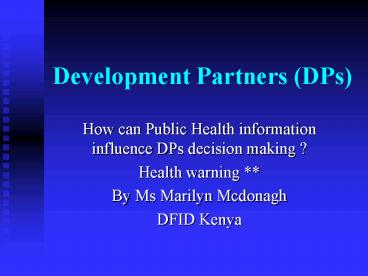Development Partners DPs PowerPoint PPT Presentation
1 / 13
Title: Development Partners DPs
1
Development Partners (DPs)
- How can Public Health information influence DPs
decision making ? - Health warning
- By Ms Marilyn Mcdonagh
- DFID Kenya
2
Historical Perspective - Donors
- Varied considerably political.
- Fragmented
- Projects covering individual donor concerns
rather than government priorities. - Individual procedures financing , procurement ,
monitoring.
3
Problems
- Established parallel systems, duplication,
undermined Gov system. - Distorted Government commitments,
- High Transaction costs for Gov, Mission fatigue
- Substituted for Gov commitment eg fund EPI, FP
Gov can uses resources on other things. - Avoided the need for Gov to make choices about
how to use available resources. - Unsustainable - EPI classic example.
4
Changes Development Partners
- Support to Gov own strategies, higher level PRSP,
ERS, - Focus on reaching poor people -
- Achievement of MDGs ,
- Complementing strategies - Programme support
rather than projects, avoid duplication and
parallel systems SWAPs, basket funding, DBS, - More focus on PEM / MTEF
- Donor Harmonisation
5
Challenges
- Budgets not allocated in support of Polices, eg
Kenya - Strategies exist but very few supported by costed
Business Plans, - Why do we need a BP - road map of how objectives
will be achieved, existing commitments, gaps and
priorities.
6
Challenges
- Discipline hard choices need to be made not
accustomed to this way of working. - Links to PER, PEM, MTEF. Budgets allocated as
last year not by what PER showed. Need for PEM. - Encourage CS to hold Gov accountable for
delivering services demand.
7
What does this mean in the health Sector?
- Gov in the driving seat.
- Strengthen Gov systems,
- Less support to individual projects , more
support to the health programme based on
prioritised costed plan. - BUT complementing strategies projects needed to
learn lessons, hard to reach marginal groups,
inefficient public services.
8
Health sector
- More contracting of Gov with NGOs rather than
DP. - Partnerships to deliver the programme, not just
the public sector. - Less earmarked money ( EPI vehicles M and E ),
more joined up working , efficiency. - Break down of empires and focus on the health
sector.
9
Decisions.
- Government Policy and Priority,
- Strengthen existing system, not establish
parallel systems - Activities - evidence based eg A/N perfunctory
,need informed choices. - Decrease in MM was it really achieved through
hospital deliveries carried out by Drs - no so
why that policy ?
10
Decisions.
- Will it impact on MDGs and how much ?
- Impact on the poor, new technologies who benefits
? How will you ensure equity ? - Cost effectiveness - opportunity cost informed
choices - Training epidemic !!
11
Decisions.
- Scale up - can the successful,activities be
rolled out nationally ? - Sustainability ?
12
Conclusion Key
- DPs seeking more to support gov policies and
strengthen gov systems through a partnership with
all stakeholders. - CSO to hold Govs accountable for providing
services.
13
- Look at how resources are allocated across the
whole HS , which means hard choices often have to
be made. - Evidence based policy making,
- Poverty and MDG focused.

